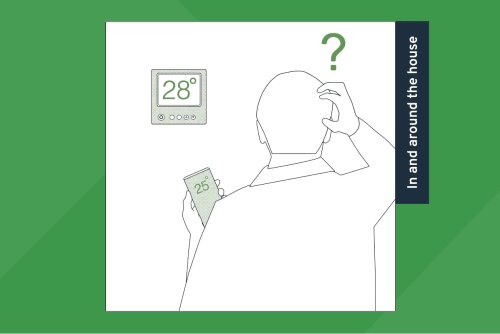I can set the programmer to 28°C but the actual temperature never gets to that - there’s something wrong with the design.
The complexity and best use of new homes will need some explanation from house builders and providers and some ‘learning’ from residents. For housing associations and landlords where tenancies might change frequently, the demonstration and induction process has to be repeated for every incoming household.
The future home will behave differently from a simple traditional home and the complexity of technology and control systems means that settings and operation are not likely to be as intuitive. The controller in the example was a standard design with a maximum temperature of 28°C on the scale. However, the heating system was never designed to get up to that temperature. There was no apparent technology failure but there was some user misunderstanding and an unfulfilled expectation.
The next question, from the elderly and vulnerable resident, was to ask why the system could not get up to 28°C. The point is that there will be some restrictions placed on householders and some changes in habits will be necessary.
A home with a low temperature heating system may not get up to temperature from cold as fast as a home heated with a gas boiler and, if it does, it may be at the expense of energy efficiency and carbon emissions. Heating systems that use central or communal systems generally distribute heat at an optimal temperature to balance heating capacity within the building with potential losses in distribution. Generally, the lower the flow and return temperatures the fewer losses will occur. Designing for actual loads, both heating and hot water, and the ‘diversity’ of use in communal systems is a very specialised activity. Rules of thumb that used to suffice will not work for the future home.
Things that can go wrong:
- unfulfilled expectations and misunderstandings, for instance slower reaction times from heating (both warming and cooling down)
- diagnostic issues for housing managers and maintainers
- counter intuitive controls.
Future-proofing recommendations:
- DESIGN: Specify heating controllers for simple operation
- INSTALL: Supplement the BREL with practical advice and support for householders
- COMMISSION: Make sure that thermostats and heating controls are also commissioned and operating properly
- MAINTAIN: Manage expectations, engage residents and share feedback and learning from similar projects.
Further Reading
Based on Smart Energy GB outlook survey (March 2019), 73% of people with smart meters have done at least one energy saving activity more frequently since getting a smart meter. (Eon Energy, web article, 12 April 2021)
Gov.uk Department for Business, Energy & Industrial Strategy, 2019 UK Greenhouse Gas Emissions
Approximately one third of the UK’s electrical energy consumption comes from the domestic sector. It equates to 17% of the UK’s 370 million tonnes of annual CO2 emissions. (Gov.uk Department for Business, Energy & Industrial Strategy, 2019 UK Greenhouse Gas Emissions, Final Figures, 2 February 2021, p13)
Energy Saving Trust, press release
New analysis by Energy Saving Trust (EST)has found that turning the thermostat down by one degree would save households £800 million and cut 3.3million tonnes of carbon emissions every year. (Energy Saving Trust, press release, updated 15 January 2021)
Report Chapters
Explore NHBC Foundation

About NHBC Foundation research
Delivering high-quality research and guidance to help the house-building industry address the challenges of delivering 21st-century new homes.

Access NHBC Foundation publications
Access and download NHBC Foundation’s full portfolio of publications and practical guides, covering primary research, research reviews and documents informing the debate.

Latest NHBC Foundation news
View the latest NHBC Foundation news, articles and facts showcasing the most recent publications and reporting on progress with new research projects.
Technical disclaimer
The information provided or contained on this website has been produced by NHBC for research and guidance purposes through the “NHBC Foundation”. It has not been created or intended for distribution or use outside of the purpose for which it was drafted. The information contained on this website does not constitute advice and is not to be relied upon by any third party. Any third party who chooses to rely upon the information contained on this website shall do so entirely at their own risk and NHBC accepts no duty of care or liability, however caused, in connection with its use or reliance by any third party. It is not updated or maintained.
This website may contain links to websites operated by third parties. Third party websites are not under our control, and we are not responsible for the content of any third-party website, or any link contained in a third-party website. NHBC do not review, approve, monitor, endorse, warrant, or make any representations with respect to third party websites. Any third party who chooses to rely upon the information contained on a third-party website shall do so entirely at their own risk. NHBC accepts no duty of care or liability, however caused, in connection with its use or reliance by any third party.
